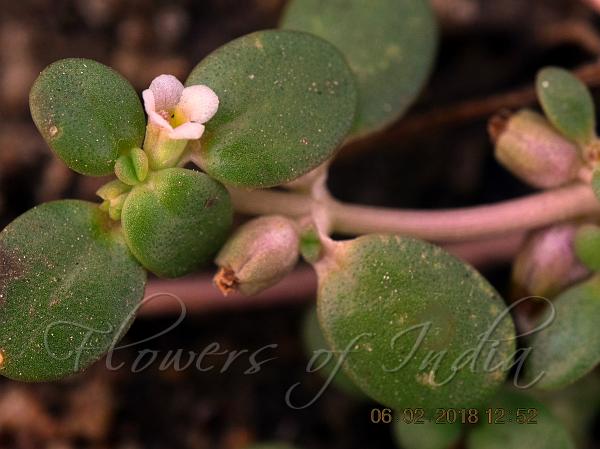|
| Marsh Peplidium |
|

|

| File size | 660357 |
| Original date | 2/6/18 12:52 PM |
| Resolution | 2048 x 1536 |
| Flash | Flash did not fire |
| Focal length | 90.0mm |
| Exposure time | 1/640s |
| Aperture | 11.0 |
| Focus Distance | |
| Metering Mode | Multi-segment |
| Camera make | NIKON CORPORATION |
| Camera model | NIKON D3300 |
| Sensor type | OneChipColorArea |
|
|
|
|
Photo: |
Botanical name: Peplidium maritimum Family: Phrymaceae (Lopseed family)
Synonyms: Peplidium humifusum, Eplidium humifusum, Microcarpaea cochlearifolia
Synonyms: Peplidium humifusum, Eplidium humifusum, Microcarpaea cochlearifolia
Marsh Peplidium is a floating-aquatic or creeping
annual herb of marshes, rooting at nodes in terrestrial plants;
hairless. Leaves are opposite, obovate, elliptic or nearly round, up to
10-18 x 6-8 mm, base narrowed from short leaf-stalk, margin entire, tip
rounded, surfaces glandular-dotted; leaf-stalks of opposite pairs
connected by a membranous ridge across the node. Flowers are borne in
leaf-axils, solitary, nearly stalkless, ebracteolate. Sepal-cup is
tubular, about 2-3 mm long, 5-ribbed, tip shallowly and bluntly
5-lobed, persistent and somewhat growing larger in fruit. Flowers are
purplish, barely extending beyond sepal-cup, about 3.5 mm long, weakly
two-lipped, upper lip 2-lobed, lower lip 3-lobed, lobes rounded.
Stamens are 2; filaments flattened, broadened towards base; anthers
yellow, unilocular. Stigma has a broad, flattened lobe. Capsules are
ovoid, tardily and irregularly splitting, rupturing at the base. Seeds
are numerous, oblong, angular. Marsh Peplidium is found in shallow
freshwater wetlands behind coastal sand dunes and in salty
sandy tidal creeks. Its native range is Egypt to Sinai, S. India, Sri
Lanka.
| Identification credit: S. Kasim | Photographed in Radharpuram, Tamil Nadu. |
• Is this flower misidentified? If yes,